
 THE POPE AND ARCHBISHOP WILLIAMS:
THE POPE AND ARCHBISHOP WILLIAMS:
First meeting after
'Anglicanorum coetibus'

Nov. 21, 2009
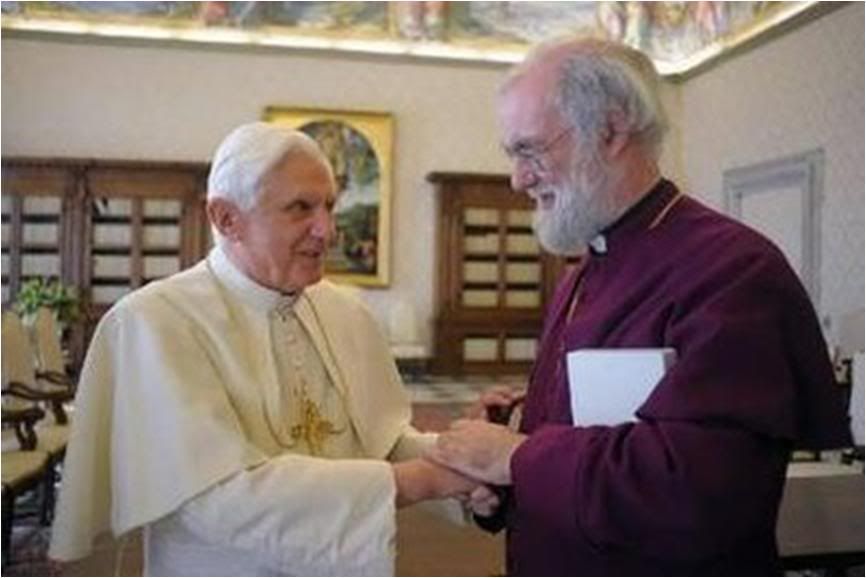

This morning His Holiness Pope Benedict XVI received in private audience His Grace Rowan Williams, Archbishop of Canterbury.
In the course of the cordial discussions attention turned to the challenges facing all Christian communities at the beginning of this millennium, and to the need to promote forms of collaboration and shared witness in facing these challenges.
The discussions also focused on recent events affecting relations between the Catholic Church and the Anglican Communion, reiterating the shared will to continue and to consolidate the ecumenical relationship between Catholics and Anglicans, and recalling how, over coming days, the commission entrusted with preparing the third phase of international theological dialogue between the parties (ARCIC) is due to meet.
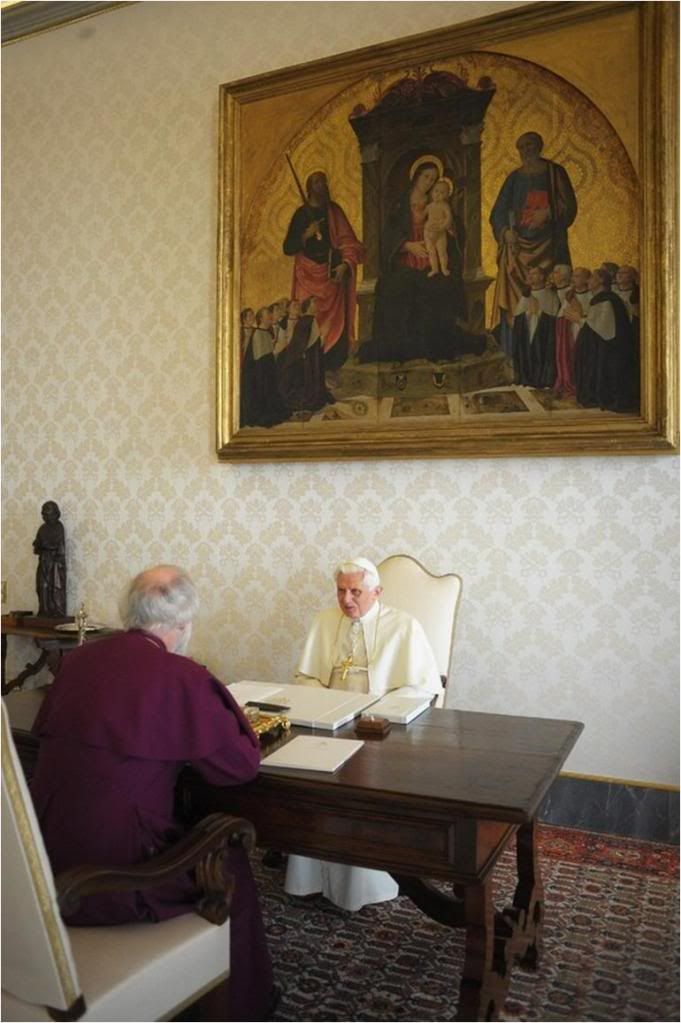
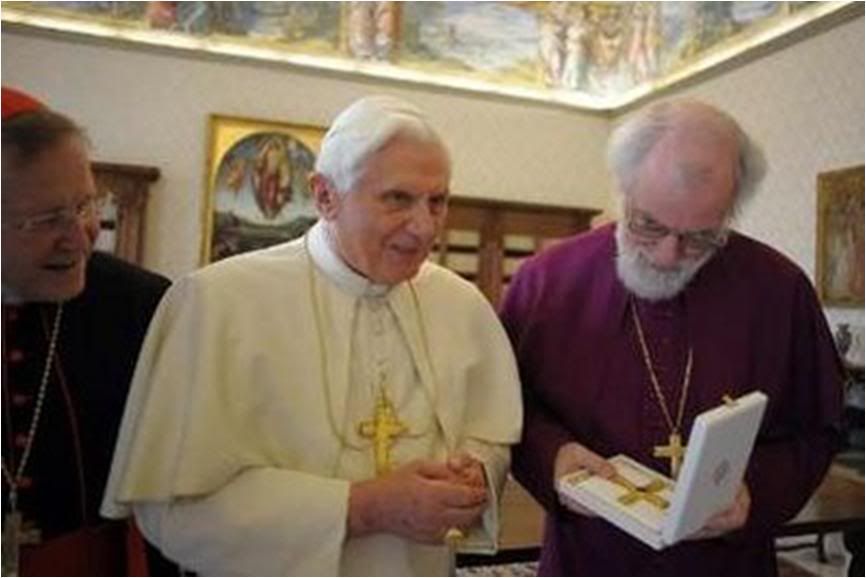 Anglican leader meets Pope
Anglican leader meets Pope
amid tensions
by Gina Doggett

VATICAN CITY. Nov. 21 (AFP) – Pope Benedict XVI and his Anglican counterpart, Archbishop of Canterbury Rowan Williams, had "cordial discussions" on Saturday, the Vatican said amid tensions between the two churches.
The strictly private meeting came just two weeks after the Vatican made it easier for disgruntled Anglicans to convert to Catholicism, a move that caught Williams off-guard, saying he had been informed of it "at a very late stage."
The two leaders "focused on recent events affecting relations between the Catholic Church and the Anglican Communion," the Vatican said in a statement, adding that they vowed to "continue and to consolidate the ecumenical relationship."
"Attention turned to the challenges facing all Christian communities at the beginning of this millennium, and to the need to promote forms of collaboration and shared witness in facing these challenges," the brief statement said.
The press has painted Williams's visit, though scheduled long before the controversy, as a "showdown" between the two churches, but observers expected a show of unity.
The Vatican's new framework for Anglicans to become Roman Catholics "is not going to halt ecumenical progress," said Reverend Doctor R. William Franklin, associate director of the American Academy in Rome.
"People are saying they are not being prevented from going forward," he told AFP.
The two church leaders will "want to demonstrate good will and show that ecumenism is going forward on other issues," agreed veteran Vatican watcher Bruno Bartoloni, referring to theological questions and the issue of papal primacy.
The Vatican unveiled on November 9 what was described by
The Times of London as "potentially the most explosive development in Anglican-Catholic relations since the Reformation."
The move, which could attract hundreds of Anglicans from around the world who oppose women and openly gay clergy, was a response to what the Holy See called "repeated and insistent" petitions.
"What has happened in reality is that both sides have recognised that ecumenism has failed," Bartoloni told AFP. "The Catholic Church has made clear that they will never agree on the question of women priests and bishops."
As a result, he said: "The Anglican reactionaries will go over to the Catholic Church. It actually suits both sides."
At a conference at Rome's Gregorian University on Thursday, Williams spoke of the "ecumenical glass (being) genuinely half-full" while acknowledging they had "unfinished business" to resolve.
The event "did a lot to help defuse the situation," said Franklin, who is also an academic fellow at the Anglican Centre in Rome.
While appearing conciliatory, Williams also laid down what he called a "challenge to recent Roman Catholic thinking" on women priests.
The archbishop asked: "Is there a way of recognising that somehow the corporate exercise of a Catholic and evangelical ministry remains intact even when there is dispute about the standing of female individuals?"
Ironically, Saturday's meeting came during long-planned events to mark the 100th anniversary of the birth of Johannes Willebrands, a Dutch cardinal who was a pioneer in Catholic ecumenism.
The Anglican Communion split from Catholicism in the 16th century, when Pope Clement VII refused to grant King Henry VIII a divorce.
The Church of England is the mother church of the worldwide Anglican Communion, which has about 77 million followers. The Catholic Church counts some 1.1 billion faithful.
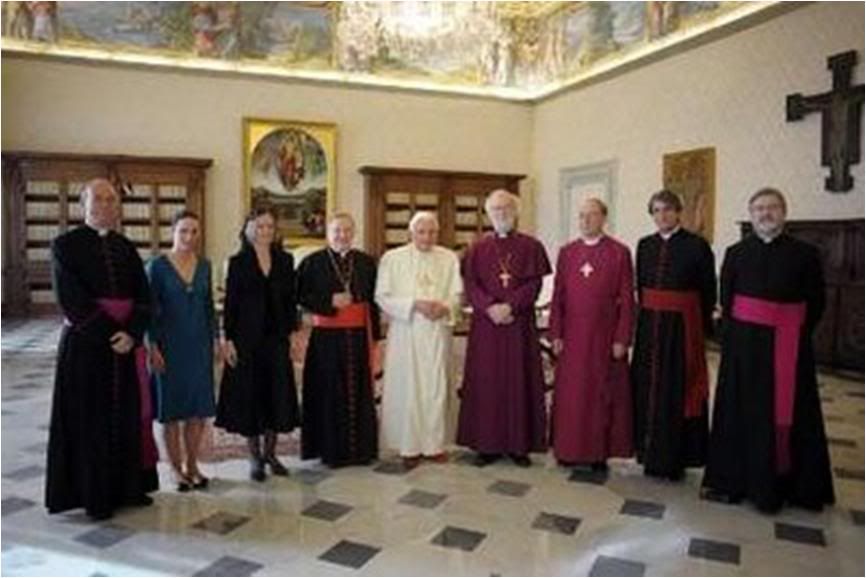 Pope and Anglican leader
Pope and Anglican leader
agree on closer relations
By VICTOR L. SIMPSON

VATICAN CITY, Nov. 21 (AP) – The archbishop of Canterbury held his first talks Saturday with Pope Benedict XVI since the Roman Catholic Church's unprecedented invitation to disaffected Anglicans, with the Vatican saying the two sides still want to press ahead for closer relations.
Archbishop Rowan Williams and Benedict met privately for 20 minutes in what the Vatican called "cordial discussions," as part of what has clearly been a difficult visit by the Anglican leader.
The Vatican said in a brief statement that the two leaders "turned to the challenges facing all Christian communities" and the need "to promote forms of collaboration and shared witness in facing these challenges."
Referring to the recent overture for traditional Anglicans upset over the ordination of women and gay bishops to become Catholics, it said the talks reiterated "the shared will to continue and to consolidate the ecumenical relationship between Catholics and Anglicans."
The Vatican said the Pope presented the archbishop with a gold bishop's cross as a gift.
There was no immediate comment from the Anglican side and the Vatican declined to elaborate.
Since coming to Rome on Thursday,
Williams has sought to downplay the implications of the Vatican's unprecedented invitation.
[One would not think so, reading the British newspapers. The London Times said of the visit: "Williams in Rome" The fightback begins", which is ridiculous as 1) Williams really has nothing to fight back with; and 2) the full text of Williams's Willebrands address is available on line (the Vatican newspaper also carried it in full today in the Italian translation) - and it was not a 'fightback' message at all, even if it was understandably very defensive.
As for Williams's rhetorical question about a possible accommodation with the Catholic Church over female priests, that was all it was - rhetoric! Because he can't even get his own Communion to buy into the infamous and improbable two-track plan he proposed for the Anglicans last summer, in which dioceses, parishes and individuals could choose to take sides in the ideological divide over anti-tradition women and gay priests as well as same-sex 'marriage'.]
The Vatican says it was merely responding to the many Anglican requests to join the Catholic Church and has denied it was poaching converts in the Anglican pond.
But the move has already strained Catholic-Anglican relations and is sure to affect Williams's 77-million worldwide Anglican Communion, which was already on the verge of schism over homosexuality and women's ordination before the Vatican intervened.
In a speech at the Pontifical Gregorian University in Rome, Williams was gracious in referring to the Vatican's new policy, which he called the "elephant in the room." The policy was an "imaginative pastoral response" to requests by some Anglicans but broke no new doctrinal ground, Williams said.
He spent the bulk of his speech describing the progress that had been achieved so far in decades of Vatican-Anglican ecumenical talks and questioning whether the outstanding issues were really all that great.
Anglicans split from Rome in 1534 when English King Henry VIII was refused a marriage annulment. For decades, the two churches have held theological discussions on trying to reunite, part of the Vatican's broader, long-term ecumenical effort to unify all Christians.
But differences remain and the ecumenical talks were going nowhere as divisions mounted between liberals and traditionalists within the Anglican Communion itself.
The new policy allows Anglicans to convert to Catholicism but retain many of their Anglican liturgical traditions, including married priests. The Vatican will create the equivalent of new dioceses, so-called personal ordinariates, for these former Anglicans to be headed by a former Anglican priest or bishop.
Estimates on the number of possible converts has ranged from a few hundred to thousands.
Williams — the spiritual leader of the worldwide Anglican Communion — wasn't informed of the change until right before it was announced.
It remains to be seen how the new policy will affect Pope Benedict XVI's planned trip to Britain next year. Saturday's Vatican statement did not mention it
[because neither side has officially announced it] .
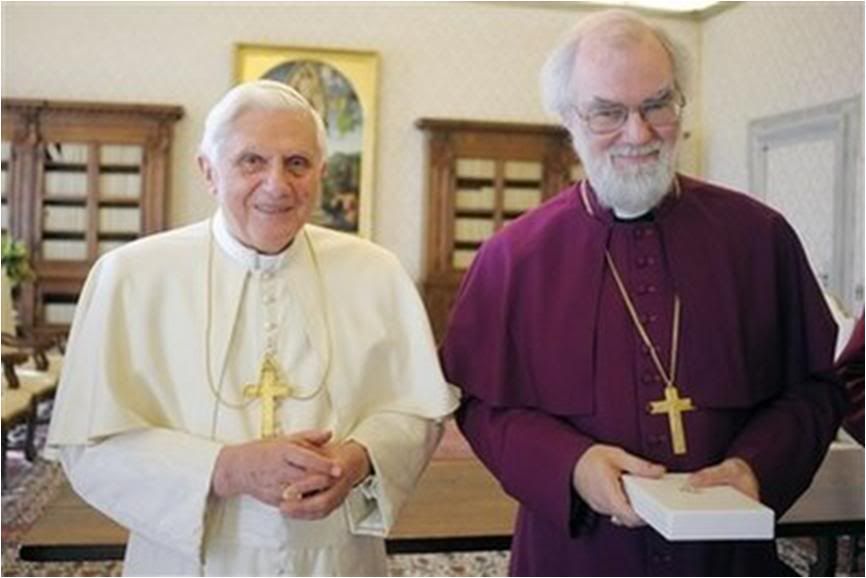 A pre-meeting article in the British daily Independent today has some surprising angles, even if the headline has nothing to do with the story!
A warm welcome from the Pope
A pre-meeting article in the British daily Independent today has some surprising angles, even if the headline has nothing to do with the story!
A warm welcome from the Pope
sows Anglican unease
By Simon Caldwell

Saturday, 21 November 2009
Pope Benedict XVI will today greet Rowan Williams, the Archbishop of Canterbury and leader of the worldwide Anglican Communion, for the first time since the Vatican announced the creation of a canonical structure to receive groups of Anglican converts en masse.
The pair will hold a private meeting at the Vatican at a delicate time for relations between the churches. Last month, Pope Benedict unveiled a special structure to allow traditionalist Anglican ministers, including married ones, and lay people to join the Catholic Church.
The decree, for the first time in history, allows the creation of "personal ordinariates" in which Anglo-Catholics can preserve their traditions but in communion with the Pope. Anglo-Catholic leaders have generally welcomed the move as an act of generosity.
But it has caused unease within parts of the Church of England because some clergy fear it could further undermine the worldwide Anglican Communion.
What Dr Williams understands more clearly than many in the Church of England is that, although he is being held accountable for many of the difficulties in his church, the creation of personal ordinariates are not a reflection on him.
He is not like an Anglican pope, a focus of unity who can hold together 80 million members by clarifying and enforcing doctrine. The ordinariates do not even reflect on the state of the Church of England, troubled as it is. The Vatican has more fertile pastures in mind.
Principally, these can be found in Australia and the United States, both countries in which one in four of the population is Catholic (compared to one in 10 in England) and where the majority of requests for group receptions from Anglicanism and into the Catholic Church have originated.
"This is not about the Church of England," one Vatican insider said. "The UK is just caught in a slipstream. The Vatican respects Rowan but it does no much care what the Church of England bishops – or indeed the Catholic bishops in England and Wales – think. The focus is all on America which Rome thinks is the most important national church, more important than Italy now."
The US Church has "healthy congregations of young people", for instance. It is robust, rich and increasingly influential. And the leaders of this church of some 60 million Catholics have been pushing for changes in the way Anglican converts are received.
This was highlighted by the embarrassment caused to the US Catholic bishops when the Episcopal bishop in New Mexico, Jeffrey Steenson, resigned over the election of Gene Robinson as the first openly gay bishop, as well as the blessing of same-sex unions.
Bishop Steenson wanted to become a Catholic priest but was made to go back to university in Rome and be re-ordained.
Instead of being welcomed as a hero, he was humiliated.
[I need to check this out.] This led for an appraisal of the way things were done.
As for Rowan Williams, the affection for him within the Vatican is genuine. He will be welcomed as a friend. He can relax. One source said: "Rome has decided to lay out a red carpet that is long and deep for Rowan because they like and respect him personally.
"They know he needs symbolic support. They can see now that he's been badly damaged by all this among Anglicans. He's playing a long game, with an eye to Anglican/RC relations, perhaps even after he and Benedict have gone, but he's being seen as too deferential ... but in the end Rome doesn't much care about England – Anglican or Catholic – they have a much wider perspective."
This insight is certainly shared by Cardinal Cormac Murphy-O'Connor, the emeritus Archbishop of Westminster. In a speech last month, he revealed that group reception was first discussed with Cardinal Ratzinger in 1993 and 1994 by the English Catholic leadership, after a request from the Anglo-Catholic group, Forward in Faith. "It was finally decided that it would not be appropriate to take this initiative," the cardinal said.
"The personal ordinariates offered by the Holy Father can be seen not in any way unecumenical but rather as a generous response to people who have been knocking at the door for a long time."